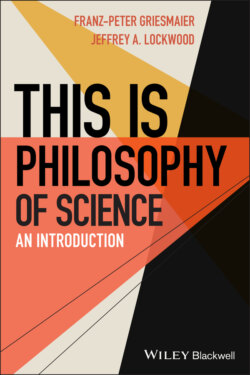Читать книгу This is Philosophy of Science - Franz-Peter Griesmaier - Страница 40
3.2.4 On Flat Earth and Bending Light
ОглавлениеConsider a member of the flat earth society. He believes that the earth is flat. Obviously, he has to defend against the evidence from partially disappearing ships. For if the flat earth theory were true, we expect to observe just continuous shrinking, but not partial disappearance. However, we do observe partial disappearance. It seems that this observation falsifies the flat earth theory decisively. However, the flat earther has a move left, even if it will strike you as some sort of a parlor trick.
In response to the partially disappearing ship, he might say something along these lines: “Well, this observation is quite compatible with a flat earth. For example, if light didn’t travel in straight lines, but was simply bent slightly toward the earth on its trip from the ship to the observer, then, after a certain distance, the light reflecting off the bottom of the ship would hit the water before it had a chance to reach the eyes of the observer. Thus, the bottom of the ship will disappear from sight before the masts will, even though the earth is flat.”
What this guy is saying sounds outrageous – light being bent? (As we’ll see, it is, as a general idea, not as outrageous as it may first seem, but it couldn’t explain the ship’s partial disappearance.) However, from the perspective of theory falsification, he has a point, namely this one: No hypothesis has observational consequences all by itself. There are always so-called auxiliary hypotheses that need to be in place as well. In our example, the “flat earth” hypothesis together with the claim that light travels in straight lines predict that a ship sailing away from the observer will shrink continuously and uniformly; it will not partially disappear. If the ship does partially disappear, I can blame one of the two claims: either that the earth is flat, or that light travels in straight lines. Either “falsity” would account for the partial disappearance.
You might still resist this move of blaming an auxiliary hypothesis (in our case, the claim that light travels in straight lines); it might strike you as cheating. But there are many other examples where this move is exactly the move to make. Suppose a group of physics majors gets a result in a lab exercise that contradicts some well-established theory. Clearly, we are not immediately going to overthrow the theory. Rather, we’ll blame the students: They didn’t set up the experiment correctly, they misread the measuring instrument, the instrument was broken, or what have you. The last thing we do is take them to have falsified classical mechanics! If we were to go there, all theories in physics, chemistry, and so on would continuously be falsified by legions of students doing lab exercises in colleges all over the US on a daily basis. Let’s not go there.
The general lesson here is this. Theories and hypotheses always rely on auxiliary hypotheses in order to generate observable predictions. This phenomenon is known as confirmation holism. It was first explicitely discussed by the French physicist Pierre Duhem, who said in his book, The Aim and Structure of Physical Theory: “To seek to separate each of the hypotheses of theoretical physics from the other assumptions upon which this science rests, in order to subject it in isolation to the control of observation, is to pursue a chimera.”2 And while Duhem restricted his discussion to physics, it is clear that the underlying point generalizes: If we don’t observe what the main hypothesis predicts, we can blame either the main hypothesis, or one or more of the auxiliary hypotheses. The outcome of the test does not tell us, however, which of the available hypotheses – main or any of the auxiliary ones – we should blame for observed discrepancies. In other words, hypotheses, and especially entire theories, which usually consist of many integrated hypotheses, cannot be conclusively falsified.
